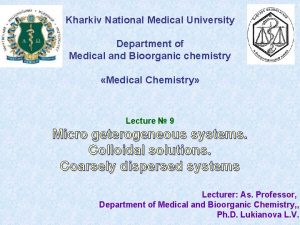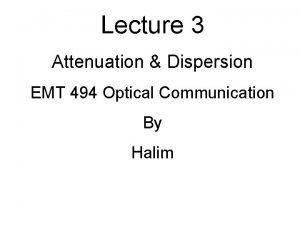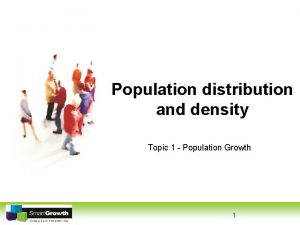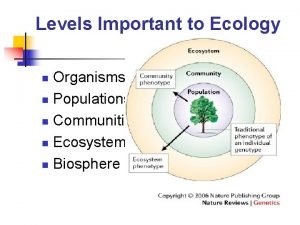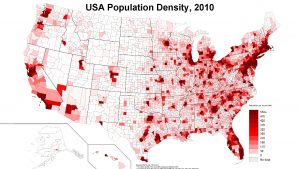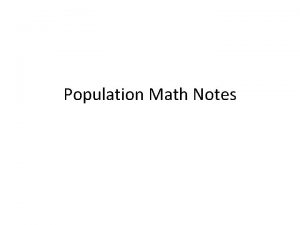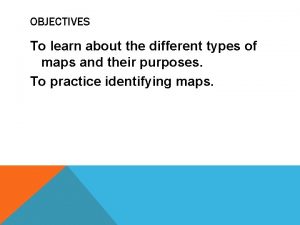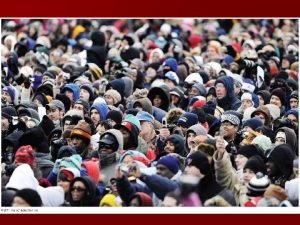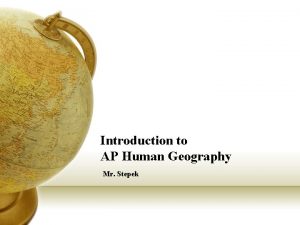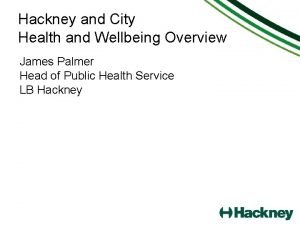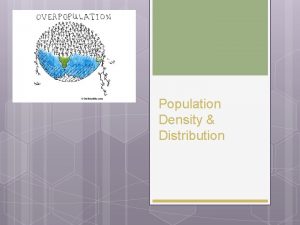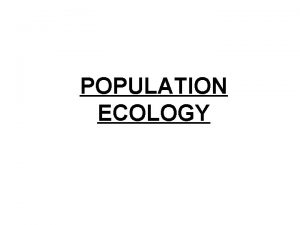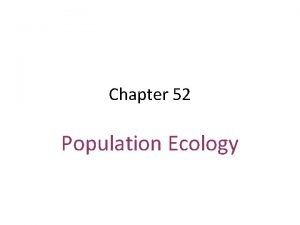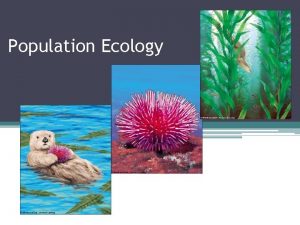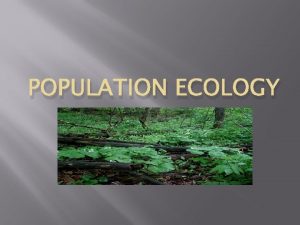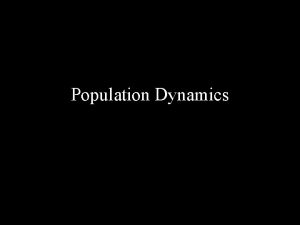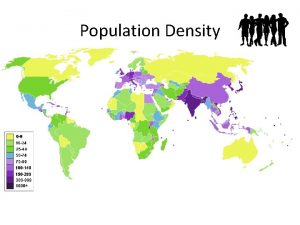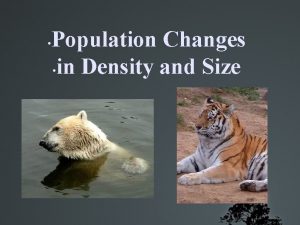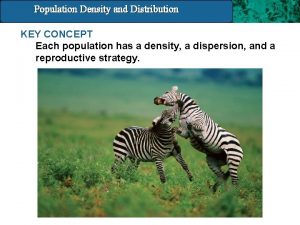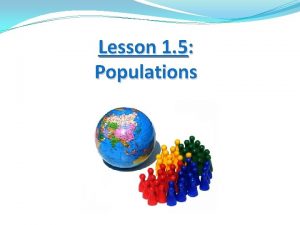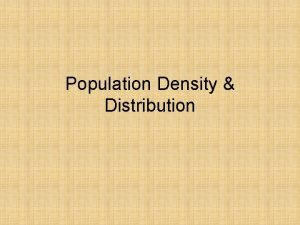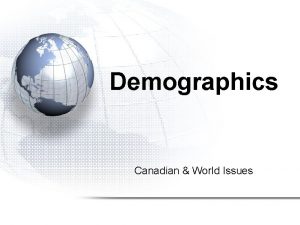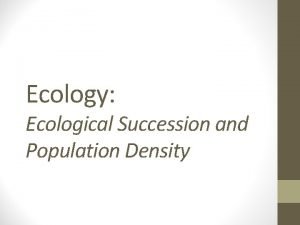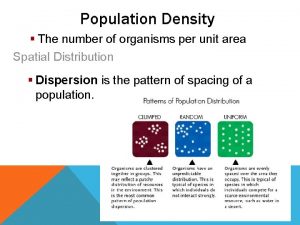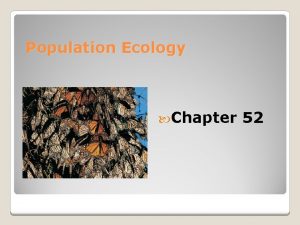CONCEPT 3 POPULATION ECOLOGY ANALYZING DENSITY DISPERSION DEMOGRAPHICS





































- Slides: 37

CONCEPT 3: POPULATION ECOLOGY – ANALYZING DENSITY, DISPERSION, DEMOGRAPHICS, GROWTH, AND FACTORS THAT AFFECT GROWTH. Chapter 53 in Campbell p. 294 -297 in Holtzclaw, Qs #3, 21, 22, 23 p. 304

POPULATION ECOLOGY You must know: How density, dispersion, and demographics can describe a population The differences between exponential and logistic growth models of population growth How density-dependent and density-independent factors can control population growth

TRY THIS! What kind of distribution does the following represent?

TRY THIS! What kind of distribution does the following represent? CLUMPING

WORKSHEET: ACT “ 52. 1” Any Questions? Let’s go over. . .















HOW CAN DENSITY, DISPERSION, AND DEMOGRAPHICS CAN DESCRIBE A POPULATION? Population Density Dispersion Clumped Uniform Random Demography Type I survivorship Type III survivorship Demographic transition






TRY THIS! Describe the Canadian human population in terms of density, dispersion, and demographics. . .

TRY THIS! Describe the Canadian human population in terms of density, dispersion, and demographics. . . Overall low density Clumped Dispersion Type I Survivorship

WHAT ARE THE DIFFERENCES BETWEEN EXPONENTIAL AND LOGISTIC GROWTH MODELS OF POPULATION GROWTH? Life History Age of reproduction Frequency of reproduction Number of offspring per reproduction How do the life histories of the dandelion and the coconut palm compare?

WHAT ARE THE DIFFERENCES BETWEEN EXPONENTIAL AND LOGISTIC GROWTH MODELS OF POPULATION GROWTH? Exponential Growth Model

WHAT ARE THE DIFFERENCES BETWEEN EXPONENTIAL AND LOGISTIC GROWTH MODELS OF POPULATION GROWTH? Logistic Growth Model K=carrying capacity

WHAT ARE THE DIFFERENCES BETWEEN EXPONENTIAL AND LOGISTIC GROWTH MODELS OF POPULATION GROWTH? What type of growth model does this Daphnia show?

WHAT ARE THE DIFFERENCES BETWEEN EXPONENTIAL AND LOGISTIC GROWTH MODELS OF POPULATION GROWTH? r-selection – density independent selection vs K-selection – density dependent selection Density dependent factors include” Competition Territoriality Disease predation

TRY THIS! 1) Which of the following best describes opportunistic, or r -strategy, organisms? (a) They reach sexual maturity rapidly (b) They reach their adult size slowly (c) They attain a large body size (d) They live for a long time (e) The size of their population remains fairly constant

TRY THIS! 1) Which of the following best describes opportunistic, or r -strategy, organisms? (a) They reach sexual maturity rapidly (b) They reach their adult size slowly (c) They attain a large body size (d) They live for a long time (e) The size of their population remains fairly constant

TRY THIS! a)What is the type of growth from 1 -7 days? b) What does the dashed line represent? c) After 9 days, is the population regulated by density dependant or independent factors?

TRY THIS! a)What is the type of growth from 1 -7 days? Exponential b) What does the dashed line represent? Carrying capacity (K) c) After 9 days, is the population regulated by density dependant or independent factors? Density dependent

NOW… Do questions #3, 21, 22, 23 p. 304 in Holtzclaw Answer the AP free response question (handed out in class) on a separate piece of paper – DUE next class We will be peer assessing your answers, you MUST bring it to class! Checkpoint next class covering Concept 2 (Biomes) and Concept 3 (Population Ecology)
 Population ecology section 1 population dynamics answer key
Population ecology section 1 population dynamics answer key Population ecology section 1 population dynamics answer key
Population ecology section 1 population dynamics answer key Population ecology section 1 population dynamics
Population ecology section 1 population dynamics Chapter 4 section 1 population dynamics study guide
Chapter 4 section 1 population dynamics study guide What does arithmetic density tell us
What does arithmetic density tell us Concept 3 population ecology
Concept 3 population ecology Dispersion phase and dispersion medium
Dispersion phase and dispersion medium Types of colloids
Types of colloids Attenuation fiber
Attenuation fiber Clumped dispersion
Clumped dispersion Logistic growth ecology definition
Logistic growth ecology definition Organismal ecology
Organismal ecology Population vs community ecology
Population vs community ecology Chapter 53 population ecology
Chapter 53 population ecology Chapter 36 population ecology
Chapter 36 population ecology Ecology
Ecology Lynx and hare relationship
Lynx and hare relationship Chapter 53 population ecology
Chapter 53 population ecology Population characteristics ecology
Population characteristics ecology Section 1 population dynamics answer key
Section 1 population dynamics answer key Population characteristics
Population characteristics What is population ecology
What is population ecology Population definition ecology
Population definition ecology Population ecology
Population ecology Parasitism pictures
Parasitism pictures Chapter 53 population ecology
Chapter 53 population ecology Analyzing population pyramids
Analyzing population pyramids Define specific weight
Define specific weight Planar atomic density bcc 111
Planar atomic density bcc 111 Linear density of fcc 110
Linear density of fcc 110 High density low density
High density low density Why is arithmetic density also called crude density?
Why is arithmetic density also called crude density? Tennessee population density map
Tennessee population density map Formula of birth rate
Formula of birth rate Nj population density
Nj population density Name something associated with china
Name something associated with china Flow line maps
Flow line maps Hackney population density
Hackney population density






